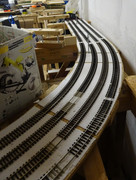Page 2 of 2
Re: How to curve Flextrack
Posted: Sun Oct 27, 2019 11:42 am
by teedoubleudee
bulleidboy wrote: ↑Sun Oct 27, 2019 8:37 am
When I got to the curves on my layout, I just used a piece of wood about 2" sq. stepped at each end so that it sat on the boards at the sides of the room, I placed a screw dead centre, to which a piece of string was attached (tied), with a pencil on the other end. I wound the string around the pencil, so that, at the sides, the pencil sat dead centre at the end of the straight track, then keeping the string taught, drew a line around the end of the room (on the end boards), until I reached a point where the straight track would continue on the other side of the room. I then placed the flexi-track (Peco Code 75) over the pencil line and pinned it down. If the radius needed to be greater or smaller I just wound or unwound the string on the pencil. I have a full set of Tracksetta gauges which also helped. All very straightforward and simple.
That's more or less the way I did my recent extension. Having a set of tracksetta gauges also helps in creating the transient curve sections.
Re: How to curve Flextrack
Posted: Sat Feb 15, 2020 9:01 pm
by PomDave
I use this idea and for parallel curves, good old Peco Tracksetter fits the job.
Dave R.
Re: How to curve Flextrack
Posted: Sun Feb 16, 2020 6:56 pm
by RAF96
Its not so much getting the curves right but the general faff of working with flexi track just puts me off using it. I can put up with the poor aesthetics of set track curves just for the lack of hassle. I seem to have half a box of flexi left and an empty wallet from buying relatively expensive replacement set track curves.
Re: How to curve Flextrack
Posted: Mon Feb 17, 2020 11:44 pm
by RSR Engineer
The method in the video may work for N gauge finescale track but the inherent springness of 16.5 mm gauge code 100 makes it virtually impossible to curve it permanently in this way. Unless, of course, the rails sit very tightly in the "chairs", which brings the problem of stopping the sleepers from getting out of parallel. I laid some s/h Roco stuff with just that arrangement of sleepers and webs in my (thank goodness!) hidden sidings and the effect was dire. And you'd never get away with forcing it with the trammel like that. There is also the little matter of avoiding doglegs at the joins. You have to "massage" the track at least to approximately the curve you want - I pin mine then to maintain the precise alignment. For parallel and concentric tracks I use the Proses gauges.
Sorry, not convinced.
Cheers,
Artur
Pic of dire Roco attached.

